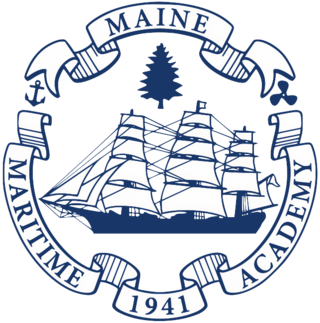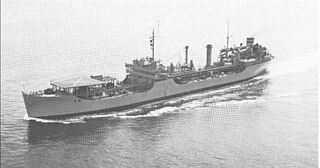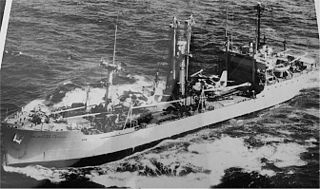For other ships with the same name, see
USS Upshur.
USNS Upshur (T-AP-198), was a Barrett Class [1] transport named in honor of Major General William P. Upshur, USMC. [2] [3]
The hull of the USNS Upshur was laid down on September 1, 1949 by the New York Shipbuilding Corporation in Camden, New Jersey as the SS President Hayes. Designed in 1947 as a passenger-cargo ship for the American President Lines' post-World War II replacement program, [1] [4] before she was completed in her civilian configuration, she was requisitioned by the U.S. Navy at the outbreak of the Korean War and converted for troop and dependent transport. [3] [4] Reassigned to the US Navy and renamed USNS Upshur, she served the Military Sea Transportation Service from 1952 to 1973. [1] Over her years of service she performed many routine missions, carrying military members and their families safely across the seas in an era when air travel was uncommon, as well as special missions, such as the emergency evacuation of military families from Guantanamo Bay Naval Base in 1962. [5]
In 1973 USNS Upshur was placed out of service and transferred to the United States Maritime Administration (MARAD), and provided to the Maine Maritime Academy for use as a merchant marine training ship. [1] [4] Renamed TV State of Maine, she served from 1973 to 1995 in service of the academy, with temporary assignments to the Massachusetts Maritime Academy. [1] [4]
In 1995 ex-USNS Upshur was transferred to the U.S. Coast Guard and relocated to Mobile, Alabama as a platform for testing maritime firefighting technology by the U.S. Coast Guard Fire & Safety Test Detachment in Mobile. [1]
In 2005, Hurricane Katrina broke the ex-USNS Upshur free of her moorings and settled her 500 feet across the Mobile River on the bank of a coal terminal. [4] In 2008 she suffered further damage when Hurricane Ike hit the area, and the vessel bottomed out and sat at a ten‐degree list. [4] According to Google Earth, the vessel was removed from Little Sand Island between May 2010 and July 2011.
USNS Upshur is associated with noted naval architect George G. Sharp and participated in several notable events in U.S. history, but, based on her current condition, MARAD has determined that she is not eligible for listing on the National Register of Historic Places. [4]
Upshur was scrapped at Brownsville, Texas in 2011. [6]

Maine Maritime Academy is a public college focused on maritime training and located in Castine, Maine. The academy was established by the 90th Maine Legislature on March 21, 1941. Unlike federal service academies, a congressional recommendation is not required to attend this state school. Students are not obligated to go to sea or into the military after graduation, and a large portion of the graduating class chooses shore-side employment, often in maritime-related fields or the power generation industry.

SS Mission Capistrano was a Type T2-SE-A2 tanker built for the United States Maritime Commission during World War II. After the war she was acquired by the United States Navy as USS Mission Capistrano (AO-112). Later the tanker transferred to the Military Sea Transportation Service as USNS Mission Capistrano (T-AO-112). She was a Mission Buenaventura-class oiler and was named for San Juan Capistrano in San Juan Capistrano, California.

USNS Redstone, designated T‑AGM‑20, was a tracking ship assigned to Apollo space mission support under the control of the Eastern Range. For a brief time during conversion the ship was named Johnstown with the designation AGM‑20.
SS Mission San Antonio was a Type T2-SE-A2 tanker built for the United States Maritime Commission during World War II. After the war she was acquired by the United States Navy as USS Mission San Antonio (AO-119). Later the tanker transferred to the Military Sea Transportation Service as USNS Mission San Antonio (T-AO-119). She was a Mission Buenaventura-class oiler and was named for Mission San Antonio de Padua located near Jolon, California.
SS Mission San Jose was a Type T2-SE-A2 tanker built for the United States Maritime Commission during World War II. After the war she was acquired by the United States Navy as USS Mission San Jose. Later the tanker transferred to the Military Sea Transportation Service as USNS Mission San Jose. She was a Mission Buenaventura-class oiler and was named for Mission San José, located in Fremont, California.
SS Mission San Carlos was a Type T2-SE-A2 tanker built for the United States Maritime Commission during World War II. After the war she was acquired by the United States Navy as USS Mission San Carlos (AO-120). Later the tanker transferred to the Military Sea Transportation Service as USNS Mission San Carlos (T-AO-120). She was a Mission Buenaventura-class oiler and was one of two U.S. Navy vessels named for Mission San Carlos Borroméo de Carmelo, located in Carmel-by-the-Sea, California, the other being Mission Carmel.

USS General J. H. McRae (AP-149) was a General G. O. Squier-class transport ship built for the United States Maritime Commission during World War II. In 1946 she was transferred to the US Army and operated as USAT General J. H. McRae. On 1 March 1950 she was transferred to Military Sea Transportation Service and operated as USNS General J. H. McRae (T-AP-149). She was named for US Army Major General James H. McRae.
USTS Empire State VI (T-AP-1001), callsign KKFW, IMO number 5264510, was a troop ship of the United States Navy and training vessel of the United States Maritime Service.

SS Twin Falls Victory, named after Twin Falls, Idaho, was a Victory ship built for World War II. Converted to a Missile Range Instrumentation Ship, she was initially operated by the US Air Force as USAF Twin Falls Victory, before coming under US Navy control and being named USNS Twin Falls (T-AGM-11/T-AGS-37). She later had a third career as the training ship SS John W. Brown II.

USNS Comet (T-AK-269), later T-LSV-7, later T-AKR-7, later SS Comet, is a vehicle landing ship built for the United States Navy. The lone ship of her class, she is named for the comet, and is the fourth U.S. Naval vessel to bear the name.

TS State of Maine is the current training ship of the Maine Maritime Academy. Formerly in United States Navy service as the USNS Tanner (T-AGS-40), she assumed her present name and role in June 1997.

The SS Arcadia Victory was a Victory ship built during World War II for cargo shipping. She was launched by the California Shipbuilding Company on 1 July 1944 and completed on 22 September 1944. The ship's United States Maritime Commission designation was VC2- S- AP3, hull number 41.

USS General D. E. Aultman (AP-156) was a General G. O. Squier-class transport ship for the U.S. Navy in World War II. The ship was crewed by the U.S. Coast Guard throughout the war. She was named in honor of U.S. Army general Dwight Edward Aultman. She was transferred to the U.S. Army as USAT General D. E. Aultman in 1946. On 1 March 1950 she was transferred to the Military Sea Transportation Service (MSTS) as USNS General D. E. Aultman (T-AP-156). She was later sold for commercial operation under the name SS Portland, before being scrapped some time after October 1986.

USS General H. B. Freeman (AP-143) was a General G. O. Squier-class transport ship for the U.S. Navy in World War II. The ship was crewed by the U.S. Coast Guard until decommissioning. She was named in honor of U.S. Army general Henry Blanchard Freeman. She was transferred to the U.S. Army as USAT General H. B. Freeman in 1946. On 1 March 1950 she was transferred to the Military Sea Transportation Service (MSTS) as USNS General H. B. Freeman (T-AP-143). She was sold for commercial operation in 1965, and eventually scrapped.

USS General W. F. Hase (AP-146) was a General G. O. Squier-class transport ship for the US Navy in World War II. She was named in honor of US Army Major General William Frederick Hase. She was transferred to the US Army as USAT General W. F. Hase in 1946. On 1 March 1950 she was transferred to the Military Sea Transportation Service (MSTS) as USNS General W. F. Hase (T-AP-146). She was later sold for commercial operation in 1968, before being scrapped in 1985.

USS General E. T. Collins (AP-147) was a General G. O. Squier-class transport ship for the U.S. Navy in World War II. She was named in honor of U.S. Army general Edgar Thomas Collins. She was transferred to the U.S. Army as USAT General E. T. Collins in 1946. On 1 March 1950 she was transferred to the Military Sea Transportation Service (MSTS) as USNS General E. T. Collins (T-AP-147). She was later sold for commercial operation under the name SS New Orleans, before being eventually scrapped.

USNS Fred C. Ainsworth (T-AP-181) was a troop transport that served with the United States Military Sea Transportation Service during the Korean War. Prior to her MSTS service, she served as US Army transport USAT Fred C. Ainsworth during World War II.

USNS Colonel William J. O’Brien (T-AK-246) was a US Maritime Administration (MARCOM) C1-M-AV1 type coastal cargo ship, originally planned as an Alamosa-class cargo ship. Constructed as Maiden's Eye for the MARCOM, completed in August 1945 and placed in operation by the War Shipping Administration (WSA). After the war Maiden's Eye was transferred to the US Army and renamed USAT Colonel William J. O’Brien who kept her in service until transferred to the US Navy in 1950 for operation as USNS Colonel William J. O’Brien (T-AK-246) by the Military Sea Transportation Service (MSTS) until 1973.

USS Wahkiakum County (LST-1162), previously USS LST-1162, was a United States Navy landing ship tank (LST) in commission from 1953 to 1970, and which then saw non-commissioned Military Sealift Command service as USNS Wahkiakum County (T-LST-1162) from 1972 to 1973.

USNS Marine Adder (T-AP–193) was a troop ship for the United States Navy in the 1950s. She was built in 1945 for the United States Maritime Commission as SS Marine Adder, a Type C4-S-A3 troop ship, by the Kaiser Company during World War II. In 1950, the ship was transferred to the Military Sea Transport Service of the U.S. Navy as a United States Naval Ship staffed by a civilian crew. After ending her naval service in 1957, she entered the National Defense Reserve Fleet, but was sold for commercial use in 1967. She was used in part to carry supplies to support the Vietnam War efforts. During the Summer of 1972 while in Da Nang Port, South Vietnam, a limpet mine was attached to the vessel by a swimmer, blowing a hole in the hull upon detonation. In order to save the ship, the Skipper ran it aground in the Da Nang harbor. The US Navy standby salvage ship USS Grasp with its crew of divers installed a box patch over the hole and pumped the water from the bilges, before moving the ship to a pier. US Army tanks hung from ship booms to heel the ship so that a metal patch could be welded in place to return the ship to duty. SS Transcolorado, she was chartered by the Military Sealift Command as a civilian cargo ship designated T-AK-2005.
















